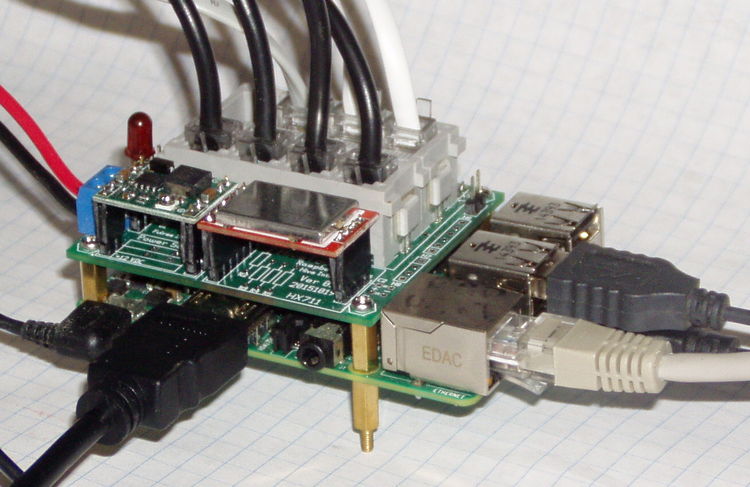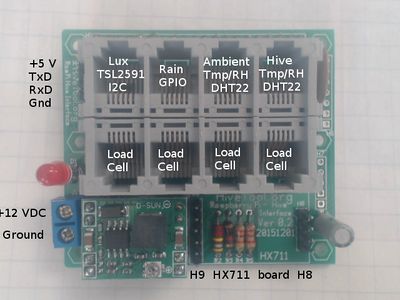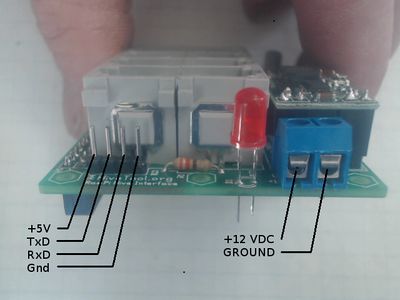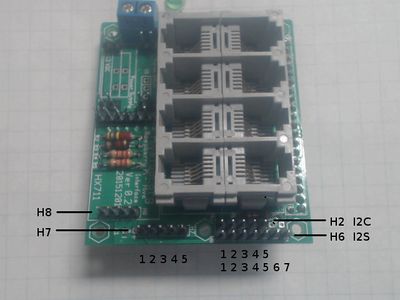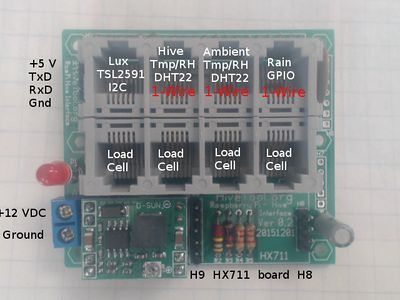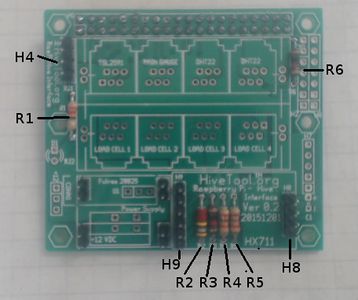Hardware: PCB Assembly
Contents
Parts
Mechanical Drawing for RJ connectors.
Board Layout
Version 0.2
21 of these boards were released.
Version 0.3
43 of these boards were released. The rain gauge was moved to a different GPIO pin. The 1-Wire bus was brought out to spare pins on the DHT22 and rain gauge connectors. The DHT22 and rain gauge connector were moved. The order of the signals on H6, the I2S connector, was changed.
Assembly
40 pin header
1. Insert the 2x20 female header from the bottom side of the board, tack two pins, and check that the header is all the way down on the board and is straight.
- Error creating thumbnail: File missing
1.1 Insert the header from the bottom.
- Error creating thumbnail: File missing
1.2 Solder one pin on each end.
- Error creating thumbnail: File missing
1.3 Check the connector for alignment.
- Error creating thumbnail: File missing
1.4 Melt solder and straighten.
2. After checking and adjusting alignment, solder the rest of the header pins on the top (component, silk screen) side of the board.
- Error creating thumbnail: File missing
2.1 Solder the rest of the pins.
Resistors
Insert the resistors in the board. If you do not plan to monitor a 12 volt supply, you may not need R2-R5. If you do not plan to use a rain gauge, you may not need R6.
| Number | Value (Ohms) | Color Code | Purpose |
|---|---|---|---|
| R1 | 330 | orange orange brown | Controls brightness of LED |
| R2 | 200K | red brown yellow | 12 V monitoring voltage divider |
| R3 | 1K | brown black red | 12 V monitoring voltage divider |
| R4 | 2.2K | red red red | 12 V monitoring Reference voltage divider |
| R5 | 2.2K | red red red | 12 V monitoring Reference voltage divider |
| R6 | 1K | brown black red | Rain gauge input filter |
- Error creating thumbnail: File missing
2.1 Insert the resistors.
Male headers
Required
- H8 1x4 and H9 1x6 for the HX711 board.
Optional
- H4 1x4 for console serial port
- H2 1x5 for I2C
- H6 1x5 for spare GPIO
- H7 1x7 for I2s
- 4 1x2 for 12 V power supply option 1.
Capacitors
| Number | Value (Ohms) | Purpose |
|---|---|---|
| C1 | 4.7 mfd. Electrolytic | Power supply filter. |
| C3 | 0.1 mfd Tantalum | Rain gauge filter. |
RJ1 and RJ2
- Error creating thumbnail: File missing
Align latch pins with holes.
- Error creating thumbnail: File missing
Check alignment.
- Error creating thumbnail: File missing
Check 16 pins are in through the hole.
- Gently hold the 4 port RJ jack on the top of the board, carefully aligning the longer latch pins on each side into the holes. When the latching pins go into the holes, the connector will
- While gently holding the RJ jack on the board, turn the board over and inspect the 16 leads. Make sure that each one is lined up with a hole.
- If all the pins are lined up, firmly press the connector in on each end and snap it in place.
Be very careful to check that all the leads are in the holes before you snap it in and solder it.
Install the HX711 board
- Install C1 4.7 mfd. Observe polarity.
- Insert the 1x4 and 1x6 female headers on the make headers.
- Install the HX711 board on the 1x4 and 1x6 female headers.
LED
- Install LED D1. Observe polarity.
- Install C3 .1 mfd. for rain gauge filter. Observe polarity if tantalum.
12 VDC power supply if used.
Power Supply Option 1: D-SUN
- Install four 1x2 male headers.
- Install blue screw terminal block.
- Install four 1x2 female headers on the four 1x2 male headers.
- Install the Power Supply board on the four 1x2 female headers.
Power Supply Option 2: Fulree
- Install Fulree voltage regulator
- Install green spring terminal block.
Testing
If using Power Supply Option 1, the voltage must be adjusted to 5.0 to 5.1 volts before connecting to the Pi or HX711 board.
